Rock-Ola 1428 nimmt keine Kredite mehr an
Rock-Ola 1428 does not accept any credits anymore
Eine 1428 nimmt plötzlich keinen Kredit mehr an. Wahlen werden nicht getätigt, d.h. die Spulen ziehen nicht mehr an. Gibt es für diesen Stromkreis eine Sicherung oder wo kann das Problem liegen? Von Hand betätigt wird die Platte gespielt.
Antwort: Ohne Kredit sind
natürlich keine Wahlen möglich.
Möglich ist, dass der sog. Master Switch in der Krediteinheit (Accumulator)
geschlossen ist. Nach dem Abbuchen des letzten Kredits muss er geöffnet
sein, damit neue Kredite angenommen werden können.
A Rock-Ola 1428 does not accept any credits all of a sudden anymore. selctions don't get made, means the selection coils do not attract. Is there a fuse for this circuit or where can the caus be? Doing the selection manually all works fine.
Answer: Without credit
selections are not possible of course.
It is possible that the so called master switch in the credit unit (=
accumulator) is closed. After subtracting the last credit this switch
must be open to accept new credits.
von Axel Rosenberger
Mit Erscheinen der
Extended-Play-Schallplatten (Singleschallplatten mit 45 Umdrehungen pro
Minute, aber zwei Liedern pro Plattenseite) reagierten die
Jukeboxhersteller darauf, indem sie, meist optional zur Nachrüstung, ein
sog. Dual-Kreditwerk lieferten. Mit diesem speziellen Kreditwerk konnte
für einen bestimmten Bereich der anwählbaren Platten der Preis angehoben
werden.
Kostete in Deutschland eine "Normalplatte" meist 20 Pfennig, so kosteten
die Platten, die preislich angehoben waren (meist Extended-Play-Platten,
sog. EP`s oder die neuen STEREO-Platten), 30 Pfennig. Je nachdem welche
der Platten der Kunde wählte, aus der "normalen" Kategorie oder der
preislich angehobenen Kategorie, zog das Dual-Kreditwerk den
entsprechenden Betrag vom eingeworfenen "Guthaben" ab.
Für die 200-er Rock-Ola Modelle
ab 1455 (letztere hatte als 1455-D standardmäßig ein
Dual-Kreditwerk) war eine Dual-Credit-Unit (DCU) liefer- und
nachrüstbar. Hierbei wurde das Standard-Kreditwerk durch das
Dual-Kreditwerk ersetzt. Erst mit Einsatz dieser DC-Unit bekamen die
kleinen Schiebeschalter im Bereich der Kategorieauswahltasten (Hit Tunes
/ Schlager der Woche; Rhythm&Blues / Jazz usw.) bzw. der Zahlentasten
(Regis und Empress) eine Funktion. Hatte der Schiebeschalter die Position
"STD", so wurde die ganze Kategorie / Zahl vom Kreditwerk als
Standardeinstellung (z.B. 20 Pfennig pro "Normalplatte") behandelt.
Schob man den Schiebeschalter auf "EP", so wurde für eine Plattenwahl
aus dieser Kategorie / Zahl ein höherer Preis verrechnet.
Hinweis: Modelle 1468 und 1478 (120 Wahlen) konnten nicht mit
einer DCU nachgerüstet werden. Denn sie
besaßen bei den Gruppentasten standardmäßig nicht die benötigten
Schiebeschalter (Umschaltung von "Standard" nach "EP").
Anmerkung 1/2019: Möglich ist, dass es die
1478 doch mit einer DCU gab. Das zeigte diese
Diskussion im Forum.
Auch die jeweils drei möglichen
SELECT- bzw.
Wähle-Lampen bekommen erst bei Verwendung einer DC-Unit ihre jeweilige
Funktion, nämlich den noch vorhandenen Guthabenbetrag anzuzeigen.
Elektrisch gab es zwischen der DC-Einheit von Tempo 1/200 und
Tempo 2/200 nur eine sehr kleine Änderung bezüglich des Aufleuchtens
bzw. Nichtaufleuchtens des Wortes SELECT bzw. WÄHLE bei bestimmten,
abgespeicherten Kreditwerten.
Bei Verwendung eines Dual-Kreditwerkes gab es folglich auch zwei Preisschilder, eines für "Normalplatten" und eines für EP- oder Stereo-Platten (siehe zwei Preisschildfenster bei Tempo 2 / Regis / Empress; bei Verwendung des Standard-Kreditwerkes wurde das Preisschildfeld für EP- oder Stereo-Platten mit einem Schild auf dem nur ein Stern zu sehen war "geschmückt").
Auf den 200er Steppern von Rock-Ola, den Modellen 1755 (in den jeweiligen Farben ocker (Modell 1455-S/1455-D), grau (1465/1475), dunkelblau (1485), metallic-hellblau (1495) und lila (1497)) findet man ebenfalls jene kleinen, oben schon erwähnten Schiebschalter zur Umschaltung von 40er-Blöcken der 200 möglichen Auswahlen von "STD" nach "EP". Zusätzlich befindet sich auf den Steppermodellen 1755 noch ein 4-poliger Stecker, der nur bei Dual-Credit eine Verwendung fand und bei Nicht-Benutzung mit einer Blindkappe abgedeckt war.
Folglich war auch der Stepper, Modell 1755 für Dual-Credit Anwendungen vorbereitet. Allerdings ist mir keine 1555/1557 Rock-Ola Wallbox bekannt, die diese Dual-Credit Option hätte nutzen können
Falls jemand andere Erfahrungen hat, wäre eine Rückmeldung mehr als willkommen.
Vielleicht hat hier die Firma Rock-Ola die Dual-Credit-Unit Verwendung nicht zu Ende konstruiert und mit Wallboxbetrieb nie realisiert.
With the presentation of
extended-play records (standard 7" records with 45 rpm, but two songs
per side), jukebox manufacturers responded by supplying a so-called
dual-credit mechanism, usually as an option for retrofitting. With this
special credit mechanism, the price could be increased for a certain
range of selectable records.
While a “normal record” in Germany usually cost 20 Pfennig, the records
that were priced higher (mostly extended play records, so-called EPs or
the new STEREO records) cost 30 Pfennig. Depending on which of the
records the customer chose, from the “normal” category or the
higher-priced category, the dual credit unit deducted the corresponding
amount from the “credit balance” inserted.
A dual credit unit (DCU) was
available and could be retrofitted to Rock-Ola 200 selection models from
model 1455 onwards (the latter had as model 1455-D a dual-credit unit as
standard). The standard credit unit was replaced by the dual credit unit.
The small slide switches in the area of the category selection buttons
(Hit Tunes / Schlager der Woche; Rhythm & Blues / Jazz etc.) or the
number buttons (Regis / Empress) only got a function when this DC unit
was installed. If the slide switch was in the “STD” position, the entire
category / number was treated as a standard setting (e.g. 20 Pfennig per
“normal record”) by the credit mechanism. If the slide switch was moved
to “EP”, a higher price was charged for a record selection from this
category / number.
Note: Models 1468 and 1478 (120 selections) could not be
retrofitted with a DCU. This is because they did not have the required
slide switches (switching from “Standard” to “EP”) for the group buttons
as standard.
Note 1/2019:
Tough said differently, it is possible that the 1478 did exist with a
DCU. This shows this
discussion
in this forum.
The three possible
SELECT
("Wähle" in German) lamps also only take on their respective functions
when a DC unit is used, namely to display the amount of credit still
available.
Electrically, there was only a very small change between the dual credit
unit of Tempo 1/200 and Tempo 2/200 with regard to the illumination
resp. non-illumination of the word SELECT (or WÄHLE) for certain
established credit values.
When using a dual credit unit, there were consequently also two price labels, one for “normal records” and one for "EP" or "Stereo Records" (see two price windows on Tempo 2 / Regis / Empress; when using the standard credit unit, the price window for EP or "Stereo Records" was “decorated” with a small label on which only a star could be seen).
On the 200 Rock-Ola steppers, models 1755 (in the respective colours ochre (model 1455-S/1455-D), gray (1465/1475), dark blue (1485), metallic light blue (1495) and purple (1497)), you will also find the small slide switches mentioned above for switching from blocks of 40 of the 200 possible selections from “STD” to “EP”. In addition, there is also a 4-pin plug on the stepper models 1755, which was only used for dual credit and was covered with a blind cap when not in use.
Consequently, the stepper model 1755 was also prepared for dual-credit applications. However, I am not aware of any 1555/1557 Rock-Ola wallbox that could have used this dual-credit option
If anyone here has made any other experiences, a feedback would be very welcome.
Perhaps the Rock-Ola company did not design the dual-credit unit to the end and never realized it with wallbox operation.
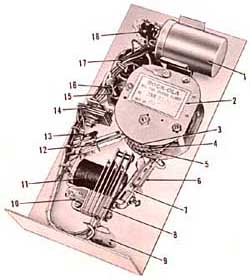
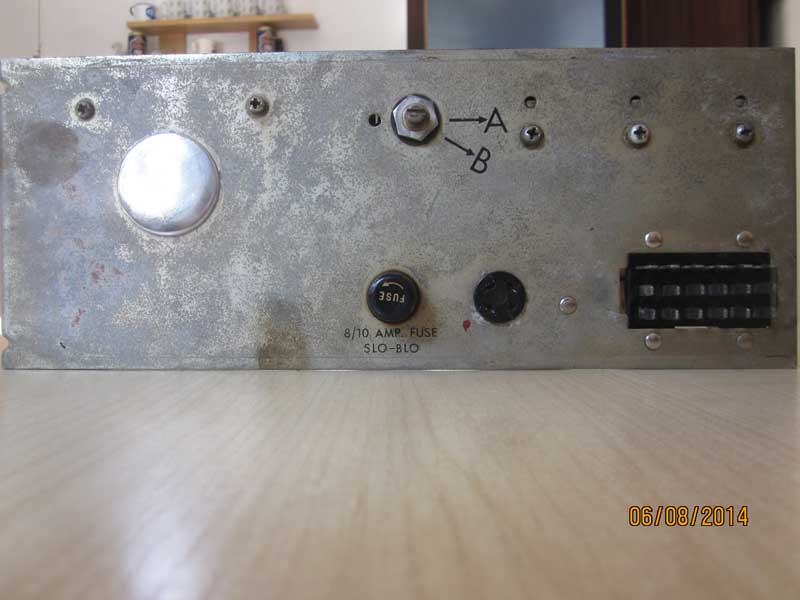
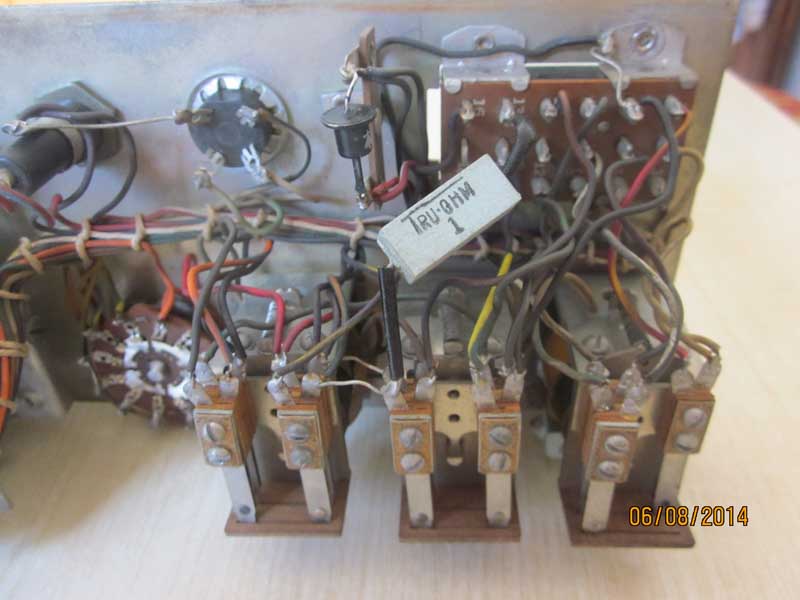
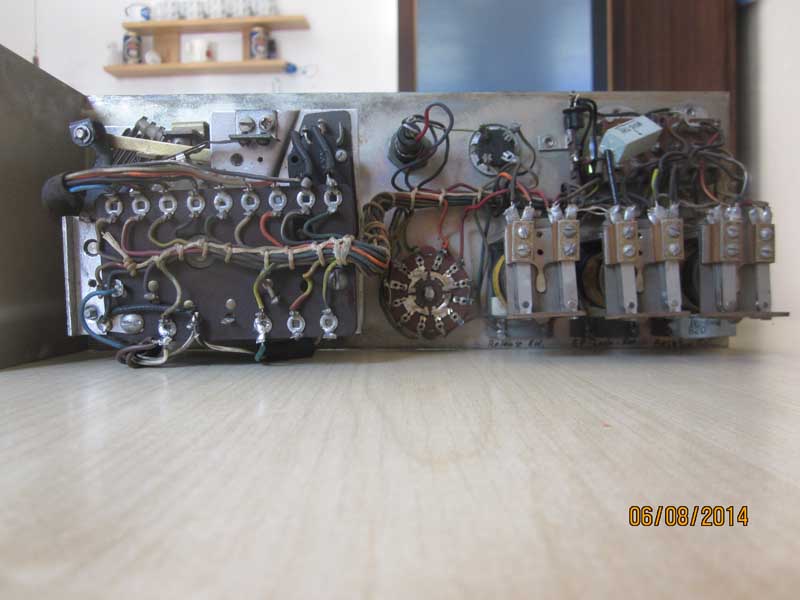
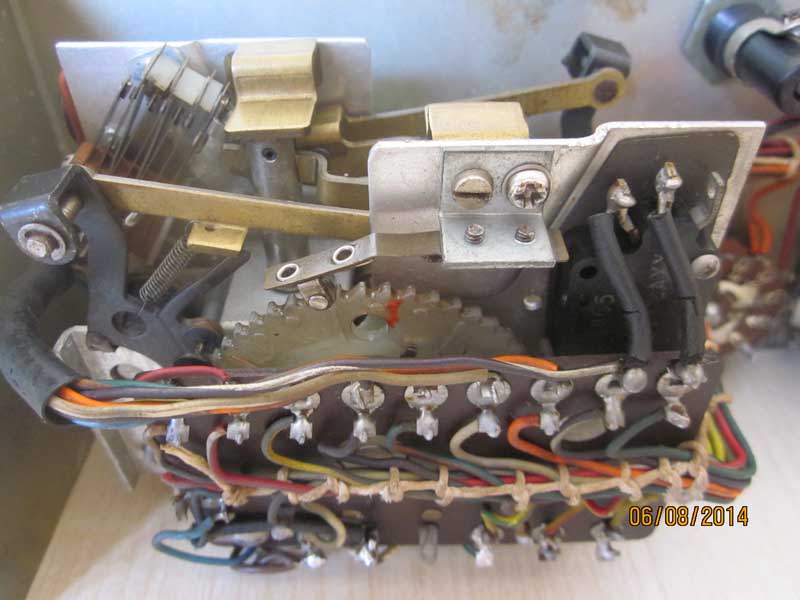
>>> Sorry, no photo yet <<<
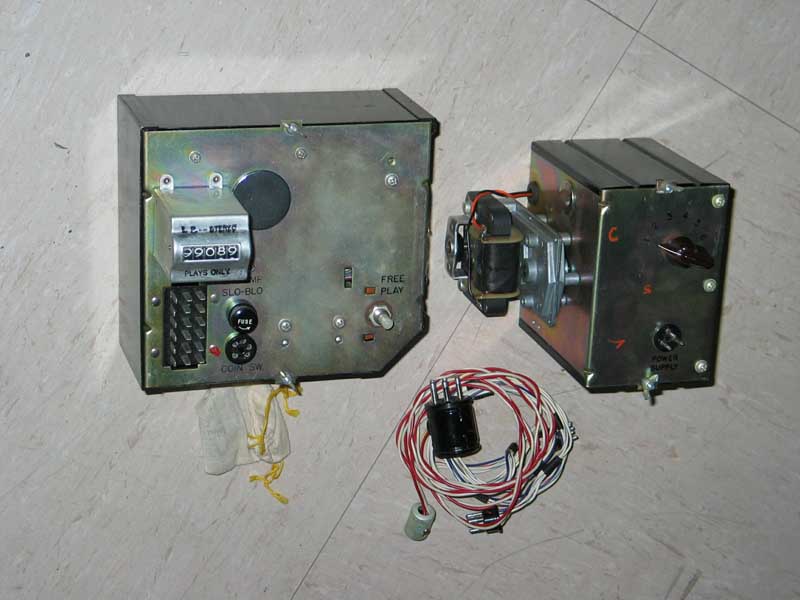
Standard Kreditgerät - Standard Credit Unit Tempo 2: 1478, 1485
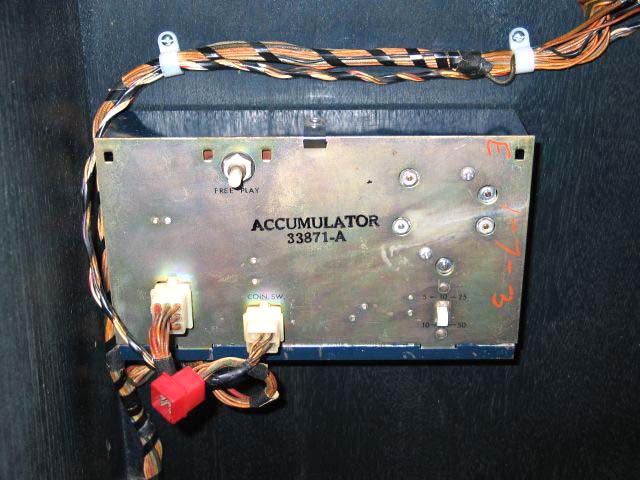
Duales Kreditgerät - Dual Credit Unit Tempo 2: 1485
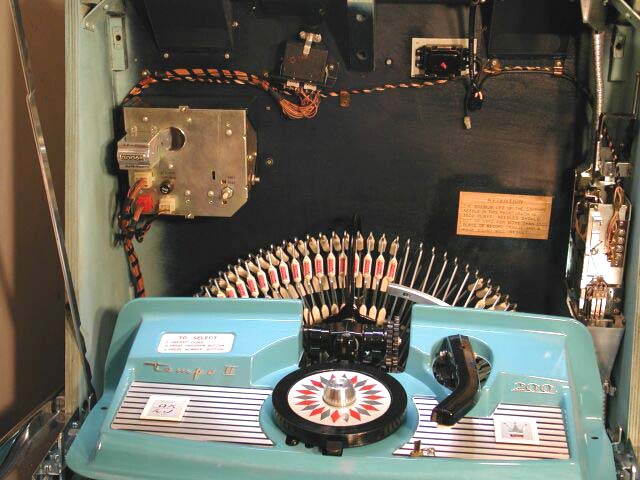
Duales Kreditgerät - Dual Credit Unit Regis: 1488, 1495
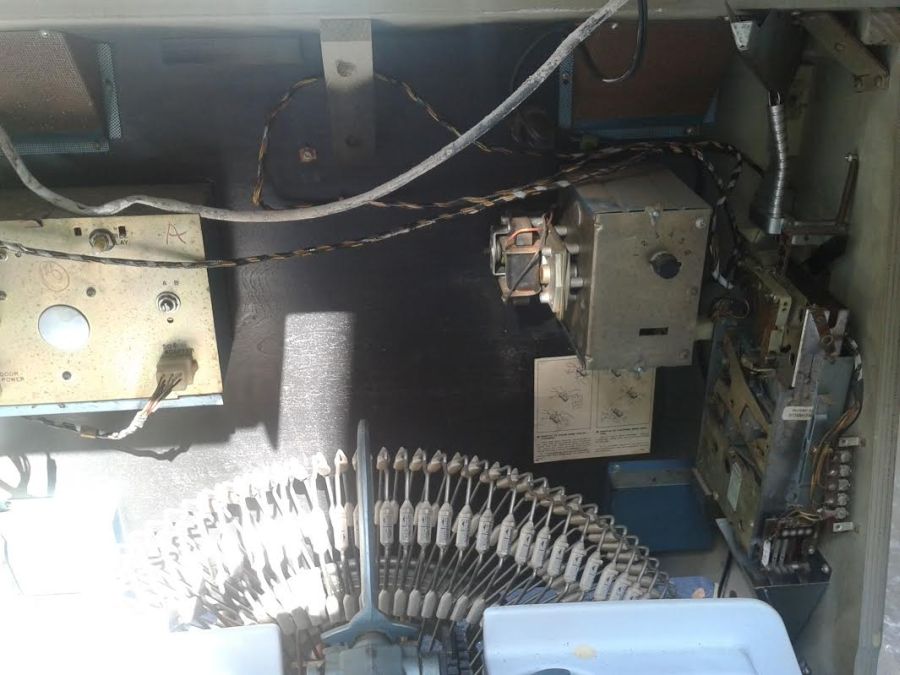
Duales Kreditgerät - Dual Credit Unit Empress: 1496, 1497
>>> Sorry, no photo yet <<<
Kontakt geht nicht in Ursprungsstellung zurück
Contact does not return to original position
Folgendes ereignet sich im Kreditgerät meiner R.O. 430: wenn ich ein Markstück (ja die gute alte Mark) einwerfe, durchläuft Sie den Münzprüfer und betätigt den unteren Hammer bzw. Hebel (Kontakt wird betätigt). Jedoch geht dieser nicht in die Ursprungsstellung zurück. Ist dort eine Feder eingebaut?
Antwort: Die
kleinen Kontakthebelchen, über die die Münzen fallen, wenn sie vom
Münzprüfer akzeptiert wurden, müssen unbedingt wieder in ihre
Ausgangsstellung (Kontakt geöffnet) zurückfedern.
Wenn diese Hebelchen nur verdreckt sind, reicht ein kleiner Spritzer
Ballistol-Öl und das Problem ist für immer gelöst. Sie können diesen
Bereich auch zerlegen und reinigen, ist aber recht fummelig.
Es kann aber auch sein, dass die Federbleche, die die Hebelchen
zurückdrücken sollen, irgendwie verbogen sind.
The following happens in the credit unit of my R.O. 430: When inserting a 1 DM coin (yes, the good old D Mark), it goes through the slug rejector and actuates the lower hammer or lever (contact is actuated). However, this does not return to its original position. Is there a spring installed there?
Answer: The small
contact levers over which the coins fall when they have been accepted by
the slug rejector must always return to their original position (contact
open).
If these levers are only dirty, a small squirt of Ballistol oil is
enough and the problem is solved for good. You can also dismantle and
clean this area, but it is quite fiddly.
However, it is also possible that the spring plates that are supposed to
push the levers back are bent in some way.
Euro-Münzprüfer: 1 EUR Kontakt ist ohne Funktion
1 EUR slug rejector: 1 EUR is without funtion
Bei meiner R.O. 414 habe
ich einen Münzprüfer mit der Kombination 1 Euro, 50 Cent und 20 Cent
eingebaut. Nun habe ich folgendes Problem: der linke Kontakt, der von
der 1 Euro Münze ausgelöst wird, ist ohne Funktion.
Der mittlere Kontakt wird von der 20 Cent Münze ausgelöst und gibt 2
Spiele.
Der rechte Kontakt wird von der 50 Cent Münze ausgelöst und gibt 6
Spiele.
Wenn ich jetzt das Kabel vom rechten Kontakt an den linken Kontakt
anlöte, müsste doch die 1 Euro Münze 6 Spiele geben, oder???
Dann das Kabel vom mittleren Kontakt an den rechten Kontakt für 50 Cent
2 Spiele anlöten. Der mittlere Kontakt wäre dann 20 Cent - 1 Spiel.
Nur was ich nicht verstehe ist, warum ich an einem Kontakt dann kein
Kredit für ein Spiel bekomme!
Wenn ich das englische Manual richtig verstehe, kann ich nur
am oberen bzw. mittleren Rad des Kreditwerkes zwischen mehreren Spielen
wählen!
Ist da nun irgendwas defekt oder ist das doch nur eine Einstellungssache
?
Der Umschaltknopf steht übrigens auf 5 - 10 - 25.
Antwort: Man lötet bei Rock-Ola keinen Münzkontakt um. Jeder einzelne Kontakt ist von 1 - 10 (12) umstellbar. Wenn der linke Kontakt ohne Funktion ist, ist wahrscheinlich die entsprechende Spule im Kreditwerk defekt oder der Münzkontakt verdreckt. Im schlimmsten Fall ist die Verbindung vom Münzkontakt zur Münz-Spule unterbrochen.
On my R.O. 414, I have
installed a slug jejector with the combination 1 Euro, 50 cents and 20
cents. Now I have the following problem: The left contact, which is
triggered by the 1 Euro coin, has no function.
The middle contact is triggered by the 20 cent coin and establishs 2
plays.
The right contact is triggered by the 50 cent coin and establishs 6
plays.
If I now solder the cable from the right contact to the left contact,
the 1 Euro coin should give 6 plays, right?
Then I solder the cable from the middle contact to the right contact for
50 cents to get 2 plays. The middle contact would then be 20 cents - 1
play.
The only thing I don't understand is why I can't get credit for a play
on one contact.
If I understand the English manual correctly, I can only choose between
several plays on the top or middle wheel of the credit unit.
Is there something wrong or is it just a matter of settings?
By the way, the switch button is set to 5 - 10 - 25.
Answer: With Rock-Ola you don't re-solder a coin contact. Each individual contact can be switched from 1 - 10 (12). If the left contact has no function, the corresponding coil in the credit mechanism is probably defective or the coin contact is dirty. In the worst case, the connection from the coin contact to the coin coil is interrupted.
Kreditgerät – Einstellung 20 Pfg., 50 Pfg, 1 DM
Credit Unit - Seetings 20 Pfg., 50 Pfg., 1 DM
|
Die 50 Pfg. und die 1 DM Münzen bei meiner Regis geben beide nur 2 Spiele statt 3 und 7. Antwort: Die
Anzahl der Kredite pro Münze lassen sich am Akkumulator einstellen. In
der Regel ist das Verfahren im Handbuch beschrieben. Abgesehen davon
sollte alles schön sauber und leichtgängig sein. |
In my Rock-Ola Regis the 50 Pfg. and the 1 DM coins both only establish 2 plays instead of 3 and 7. Answer: The
number of credits per coin can be set on the accumulator. The
procedure is usually described in the service manual. Apart from
that, everything should be nice and clean an work smoothly. |
Die Angaben haben keinen Anspruch auf Vollständigkeit oder Richtigkeit.
Bei den (importierten) Boxen können im Laufe der Jahre durchaus
Veränderungen vorgenommen worden sein. Copyright.
Ein Service von

Copyright by
Stamann Musikboxen